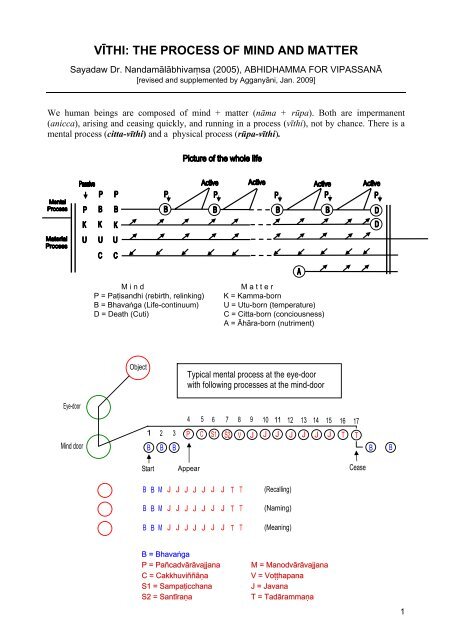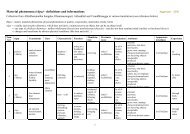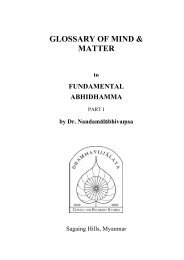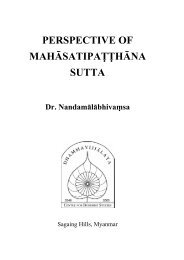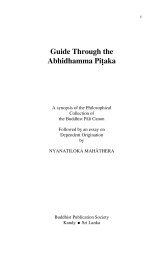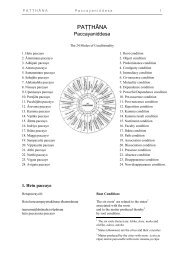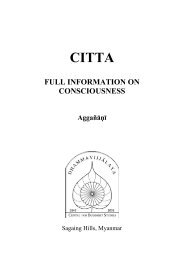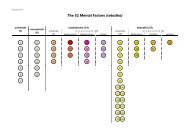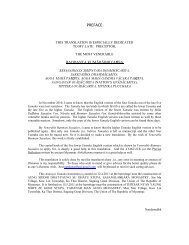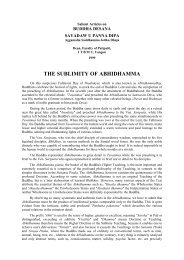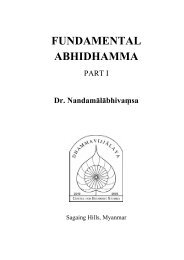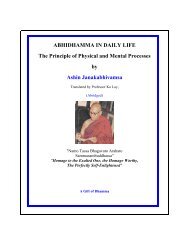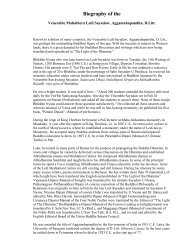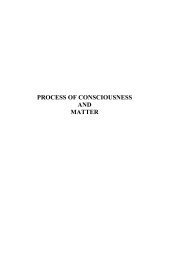vīthi - Abhidhamma.com
vīthi - Abhidhamma.com
vīthi - Abhidhamma.com
- No tags were found...
Create successful ePaper yourself
Turn your PDF publications into a flip-book with our unique Google optimized e-Paper software.
VĪTHI: THE PROCESS OF MIND AND MATTERSayadaw Dr. Nandamālābhivaṃsa (2005), ABHIDHAMMA FOR VIPASSANĀ[revised and supplemented by Agganyāni, Jan. 2009]We human beings are <strong>com</strong>posed of mind + matter (nāma + rūpa). Both are impermanent(anicca), arising and ceasing quickly, and running in a process (vīthi), not by chance. There is amental process (citta-vīthi) and a physical process (rūpa-vīthi).M i n dP = Paṭisandhi (rebirth, relinking)B = Bhavaṅga (Life-continuum)D = Death (Cuti)M a t t e rK = Kamma-bornU = Utu-born (temperature)C = Citta-born (conciousness)A = Āhāra-born (nutriment)Typical mental process at the eye-doorwith following processes at the mind-doorB = BhavaṅgaP = PañcadvārāvajjanaC = CakkhuviññāṇaS1 = SampaṭicchanaS2 = SantīraṇaM = ManodvārāvajjanaV = VoṭṭhapanaJ = JavanaT = Tadārammaṇa1
Functions of consciousness1. paṭisandhi (rebirth, relinking) 8. phusana (touching)2. bhavaṅga (life-continuum) 9. sampaṭicchana (receiving)3. āvajjana (adverting, attending) 10. santīraṇa (investigating, checking)4. dassana (seeing) 11. voṭṭhappana (determining, selecting)5. savana (hearing) 12. javana (impulsion, energetic experiencing)6. ghāyana (smelling) 13. tadārammaṇa (registration, retentive, after-effect)7. sāyana (tasting) 14. cuti (death)ConsciousnessFunctionunwholesome consciousness12 akusala cittaseye-consciousness2 cakkhu-viññāṇaear-consciousness2 sota-viññāṇanose-consciousness2 ghāna-viññāṇatongue-consciousness2 jivhā-viññāṇabody-consciousness2 kāya-viññāṇareceiving consciousness2 sampaṭicchanainvestigating consciousness with neutral feeling2 upekkhā-santīraṇa cittainvestigating consciousness with pleasant feelingsomanassa-santīraṇa cittafive-door-adverting consciousnesspañcadvārāvajjana cittamind-door-adverting consciousnessmanodvārāvajjana cittasmile-producing consciousnesshasituppāda cittagreat wholesome + great functional consciousness8 mahā-kusala + 8 mahā-kiriya cittasgreat resultant consciousness8 mahā-vipāka cittasfinematerial wholesome + functional consciousness5 rūpa-kusala + 5 rūpa-kiriya cittasfinematerial resultant consciousness5 rūpa-vipāka cittasimmaterial wholesome + functional consciousness4 arūpa-kusala + 4 arūpa-kiriya cittasimmaterial resultant consciousness4 arūpa-vipāka cittassupramundane consciousness (path + fruition)8 lokuttara cittas (4 magga + 4 phala)Rebirth - paṭisandhiLife-continuum - bhavaṅgaAdverting - āvajjanaSeeing - dassanaHearing - savanaSmelling - ghāyanaTasting - sāyanaTouching - phusanaReceiving - sampaṭicchanaInveestigating - santīraṇaDetermining - votthapanaImpulsion - javanaRegistration - tadārammaṇaDeath - cutixxxxxxxx x x x xxxxxxxxx x x xxx x xxx x xx2
Mental process at the eye-doorFour types of object (classified according their size) and number of possible mental processes:1. very large (we can see easily, like a building, a mountain, an elephant...) 12. large 23. small 64. very small (we hardly can see, like tiny insects, dust...) 6- - - -on seeing 15 different eye-door processes are possible 15(1) (2) (3) (4) (5) (6) (7) (8) (9) (10) (11) (12) (13) (14) (15) (16) (17)B p B v B a P C Sp St V J J J J J J J T T B....°°° (normally seven javanas) °°° lifecontinuumthe citta opens its door for the new objectobject starts = “gate-opener”(born here),life-span ofbut cannot enterthe object ceased(bhavaṅga has its own object: kamma, kamma-nimitta or gati-nimitta)Function of the cittas:B = Bhavaṅga: passive mind, very quietB p = past bhavaṅga, B v = vibrating bhavaṅga, B a = arresting bhavaṅgaP = Pañcadvārāvajjana = five-sense-door adverting: opens the respective sense-door for the objectC = Cakkhuviññāṇa = eye-consciousness: sees the objectSp = Sampaṭicchana = receiving consciousness: receives the objectSt = Santīraṇa = investigating consciousness: investigates the object (“checking”)V = Voṭṭhapana = determining consciousness: decides, determines the object (“selecting”)J = Javana = dynamic consciousness: experiences and enjoys the objectT = Tadārammaṇa = following consciousness: follows the javanas with the same object(mostly translated as “registration”)Very large objectB p B v B a P C Sp St V J J J J J J J T TLarge objectTwo types of processes are possible:1. B p B p B v B a P C Sp St V J J J J J J J B2. B p B p B p B v B a P C Sp St V J J J J J J JSmall objectSix types of processes are possible (more and more bhavaṅgas pass, before the object enters andthe mind be<strong>com</strong>es active, but no more javanas arise):1. B p B p B p B p B v B a P C Sp St V V V B B B B2. B p B p B p B p B p B v B a P C Sp St V V V B B B3. B p B p B p B p B p B p B v B a P C Sp St V V V B B4. B p B p B p B p B p B p B p B v B a P C Sp St V V V B5. B p B p B p B p B p B p B p B p B v B a P C Sp St V V V6. B p B p B p B p B p B p B p B p B p B v B a P C Sp St V V3
Very small objectSix types of processes are possible (only passive states of mind with vibrating bhavaṅga ariseafter 10 to 15 bhavaṅgas passed):1. B p B p B p B p B p B p B p B p B p B p B v B v B B B B B2. B p B p B p B p B p B p B p B p B p B p B p B v B v B B B B3. B p B p B p B p B p B p B p B p B p B p B p B p B v B v B B B4. B p B p B p B p B p B p B p B p B p B p B p B p B p B v B v B B5. B p B p B p B p B p B p B p B p B p B p B p B p B p B p B v B v B6. B p B p B p B p B p B p B p B p B p B p B p B p B p B p B p B v B vAlltogether: 15 vīthis at eye-door possibleAll 5 doors (eye, ear, nose, tongue, body): 5 x 15 = 75 vīthisMental process at the mind-doorAfter the eye-door process there must follow at least three mind-door processes in order to knowthe object. The first mind-door-process recalls the object (past object), the second catches theform or the word, the third knows the meaning of the object.1. Clear object: B v B a M J J J J J J J T T2. Obscure object: B v B a M J J J J J J JM = manodvārāvajjana = mind-door adverting, turning to a new mental object= “mind-door opener”T = tadārammaṇa = following consciousness / registrationMental process during attainmentWhen we practise meditation successfully, through Samathā we can attain the jhānas, throughVipassanā “Nibbāna”, that means path + fruition (magga + phala).First attainment of jhāna for a slow person: B v B a M P U A G Jh BLater attaining jhānas again (example): B v B a M P U A V Jh Jh Jh Jh Jh Jh Jh … BFirst experience of Nibbāna (sotāpanna): B v B a M P U A G Mg Ph Ph BLater experience as sotāpanna… or arahat: B v B a M P U A V Ph Ph Ph Ph Ph Ph … BB v and B a = vibrating and arresting bhavaṅgaM = manodvārāvajjana = mind-door adverting consciousnessP = parikamma = preparation consciousnessU = upacāra = access consciousnessA = anuloma = confirmityG = gotrabhū = change-of-lineageV = vodāna = cleansing (last mahākusala citta instead of gotrabhū)Jh = jhāna = first rūpāvacara kusala cittaor later any rūpāvacara or arūpāvacara cittaMg = magga = path consciousness (one of the four)Ph = phala = fruition consciousness(can arise many times and then the vīthi be<strong>com</strong>es very long)Occur as Javana-cittas.P, U, A, G, V are one ofthe four mahākusalacittas with ñāṇa but withspecial functions4
Mental process at death and rebirth4 types of death-processes in eye-door (dependent of size or strength of the object):death-process / old life1. B p B v B a P C Sp St V J J J J J T T B Cu (17) Ps2. B p B v B a P C Sp St V J J J J J T T Cu (16) Ps3. B p B v B a P C Sp St V J J J J J B Cu (15) Ps B4. B p B v B a P C Sp St V J J J J J Cu (14) Ps B BCu = Cuti = death-consciousnessPs = paṭisandhi = relinking consciousness, rebirth-consciousnessbirth-process / new lifereceivethe oldobject4 types of death-processes in mind-door (dependent of size or strength of the object):death-process / old life1. B v B a M J J J J J T T B Cu (12) Ps ...2. B v B a M J J J J J T T Cu (11) Ps ...3. B v B a M J J J J J B Cu (10) Ps ...4. B v B a M J J J J J Cu (9) Ps ...birth-process / new lifeall receivethe oldobjectThe life-span of the object is always longer than that of the death-process, so the paṭisandhialways receives this object.Arising of mind and matter in the new lifefirst vīthilast vīthi(1) (2) (3) (4) .... (17)Ps B B B .... B M J J J J J J J B B ... Cu°°° °°° °°° °°° °°° °°° °°° °°° °°° °°° °°° °°° °°° °°° °°° °°°P B B B .... B (16)○○○ ○○○ ○○○ ○○○(life-span of rūpa = 17 cittasor 51 mind-submoments)kammaja rūpacittaja rūpas start also (at arising submoments)utu (tejo) itself is kamma-born and already present in the first submomentof paṭisandhi-citta. Utuja rūpa = utu-born matter start at thesecond submoment of paṭisandhi.Concerning āhāraja rūpa, we cannot say defintely when they start to arsise.5


